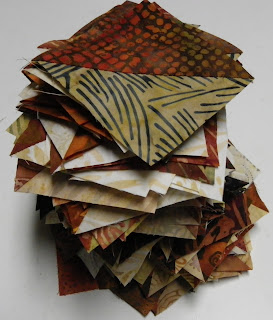I am home, safe, sound and happy from my trip overseas. I have mixed feelings abut cruising, but there is one thing I can say for sure. Having only unpacked my bag once after getting on the ship, we visited North Africa, Malta, Italy, France and Spain. That's 5 counties in 7 days. I think that is one of the beauties of cruising.
One of the highlights of my trip was visiting with
Bénédicte Bodard. I wanted to wait to write about her until I got home, to make sue that I was able to devote a lot of time and thought to her and about her. She is an amazing woman. But first I want to give you a little background.
I have been a little reticent to share my most exciting news. Some of you that have attended my lectures know and some of you who have visited my website know. Some of you may have pieced together bits and pieces of info from my blog may know. I have a book coming out in January called Quilt Fiesta - Surprising Designs From Mexican Tiles. The book was a result from a trip to Mexico. I fell in love with Mexican folk art and the possibilities that could result from taking the designs from Mexican tiles and creating quilt designs. It will be available in January and can be pre-ordered from
Amazon or from me.
So you can understand that I am extremely interested in tiles from anywhere in the world. I own several books published by Pipin Press that just have drawing after drawing of tiles in them. One of them focuses on the
tiles of Barcelona. With the impending Barcelona trip, a little internet research turned up
Bénédicte's name. So I contacted her. We agreed to meet, and I had no idea what I would learn.
Our second day in Barcelona, my husband and I took the Metro to her apartment, where I learned all about hydraulic cement tiles, which are made in a completely different way than the ceramic tiles with which I am familiar. These tiles were popular 100-150 years ago. Now when people are remodeling their homes, they are tearing them up and throwing them away.
Bénédicte loves these tiles and believes they are an integral part of history. So when she finds out about the demolition, she goes dumpster diving to save them! She then carts them back to her workshop and cleans them up. This makes it sound like it is a simple process, but it is far from that. Some of the tiles have a layer of cement still attached to them from the cement bed in which they were laid. So the cement has to be removed without breaking the tile and then the tiles usually need to be cleaned and polished. To show off the beauty of these tiles, she mounts them in small wrought iron tables or framed to hang on the wall.
I could go on and on. The tiles are beautiful and they are primarily from Spain's Modernista era which is equivalent to our Art Nouveau. Unlike glazed, shiny ceramic tiles, these tiles are mat and the colors are beautifully subdued. Oooh, the possibilities for quilts are endless. So instead of continuing to write on and on, I'll share my photos. And don't forget to go to
Bénédicte's blog.
 |
| The door to Bénédicte 's workshop. I had no idea what I had in store. | | | | | | | |
|
|
 |
| My first impression as the door was opened and we entered the basement workshop. She spends hours and hours down here each day rescuing these tiles. |
|
 |
| Piles of tiles. |
 |
| Bénédicte showing the cement on the back of a tile with stacks of cleaned and sorted tiles behind her. |
 |
| A table created from 4 tiles. You can find tables like these for sale on her blog. |
|
|
 |
| This is one of my favorite tiles that really makes me think of William Morris and the Craftsman style of houses. |
And the bonus to the visit was a gift of three tiles, as they were rescued, complete with the cement. We had to do some juggling with our luggage to deal with the weight issue flying home, but it was so worth it. I can't wait to start designing some new quilts.
 |
| Some original floors look like rugs with interior and border tiles. |
|





















































